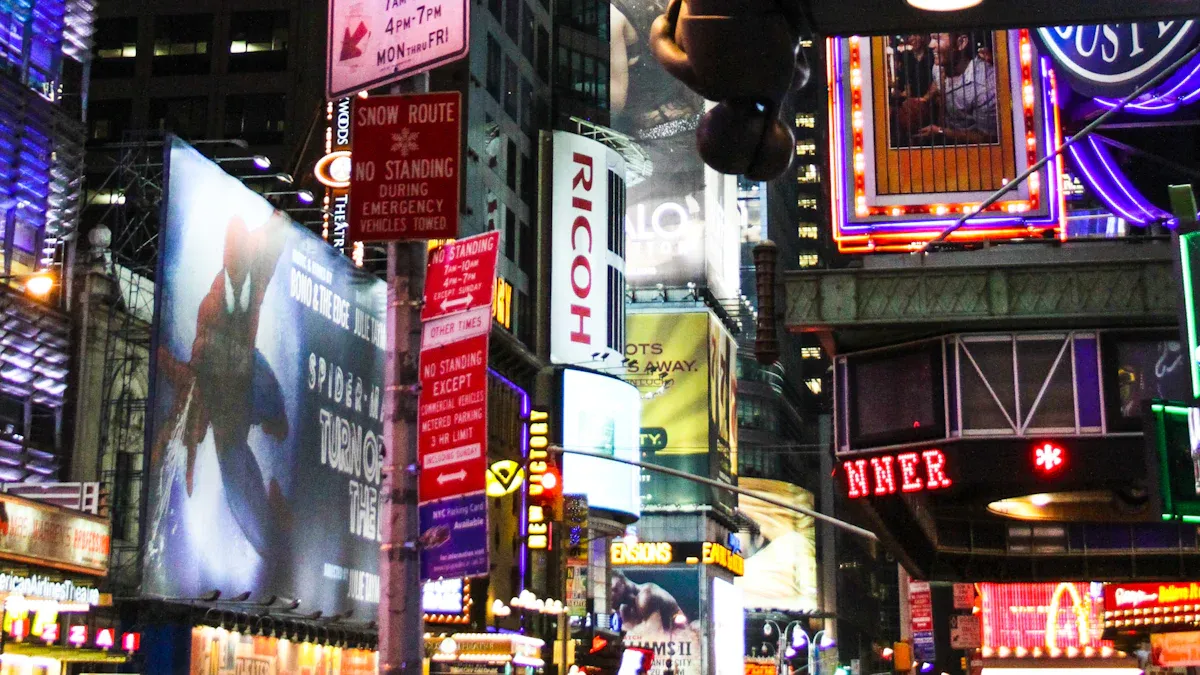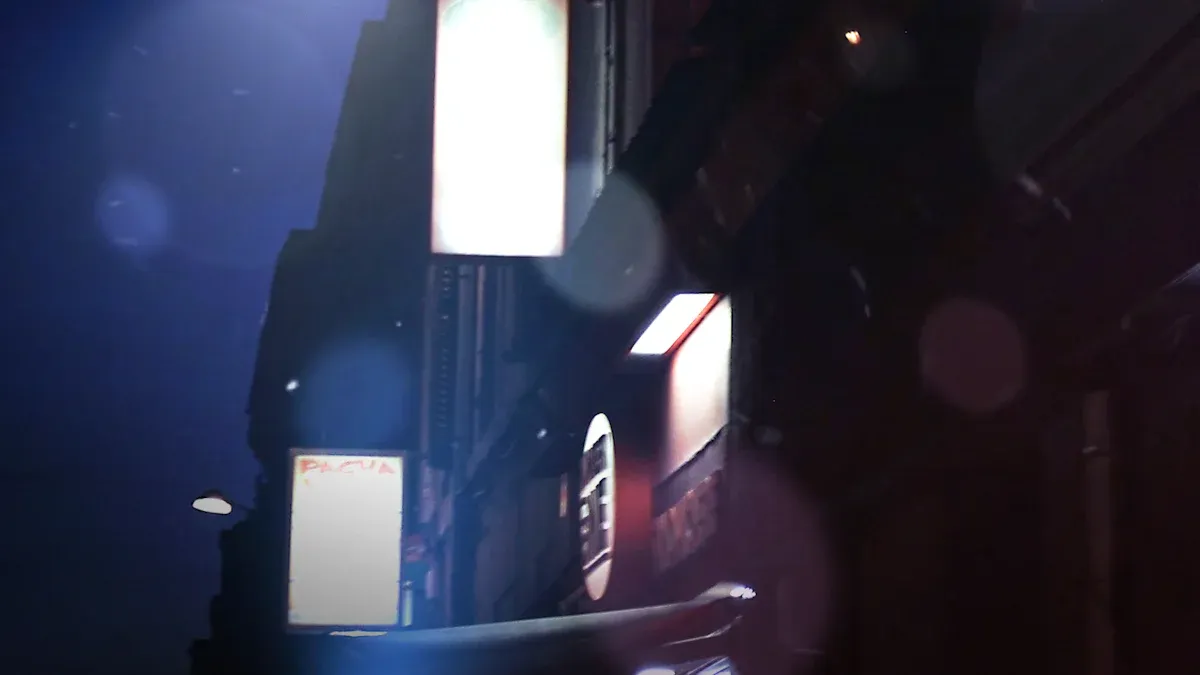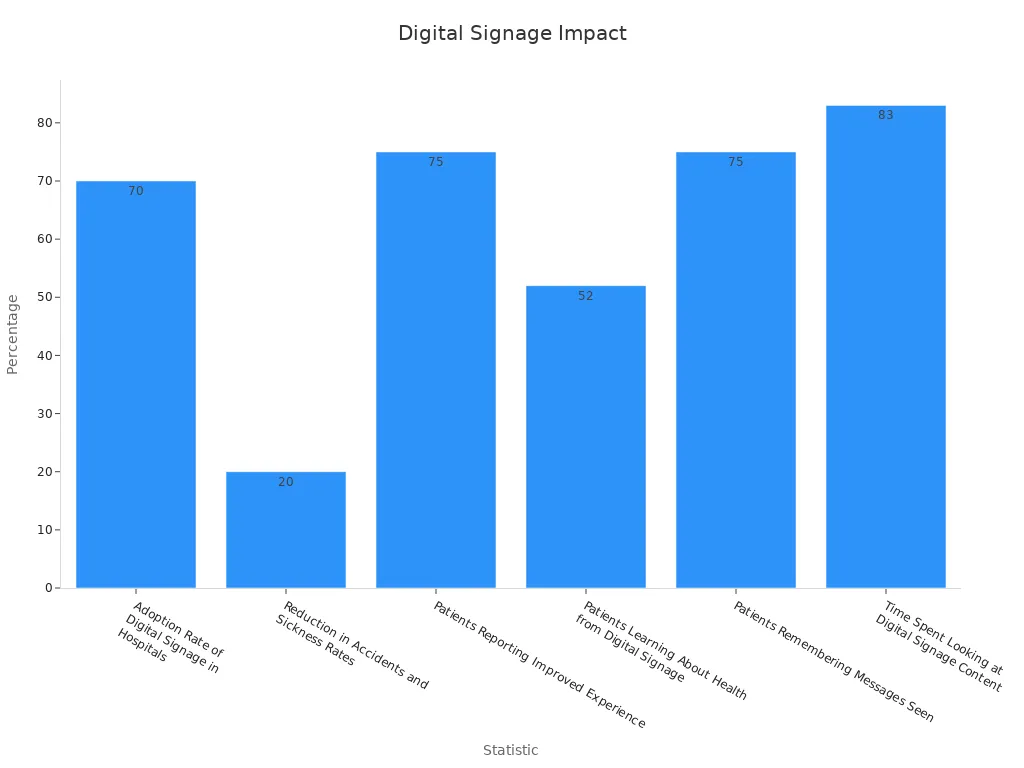Vertical Digital Signage Displays: Applications, Benefits, and Implementation Strategies

Vertical digital signage displays are tall, slim screens. They are made to catch people's attention in busy places. These screens save space and show clear, strong messages. Businesses use them to connect with customers and leave a lasting impression.
Studies show they are becoming more important. The global digital signage market might reach $23.05 billion by 2025. Retail stores make up 25% of these installations. Digital screens get 400% more views than regular signs. They help increase sales by about 31.8%. Hospitals say they cut wait time feelings by 21%. Also, 68% of shoppers say digital signs affect what they buy.
If you want to reach people and grow your brand, vertical digital signage is a great choice.
Key Takeaways
Vertical digital signs help businesses grab attention and show their brand.
They work well in places like stores, hospitals, and hotels to share info and make customers happy.
Updating the screen often keeps messages new and interesting for people.
Picking the right kind of sign and where it goes is key to making it work best.
Checking how signs perform using money and attention stats helps improve plans.
Applications of Vertical Digital Signage

Vertical digital signs have changed how businesses talk to people. These screens are useful and grab attention, making them great for many industries. Here are some ways they are used.
Retail and Shopping Malls
Stores use vertical signs to catch eyes and improve shopping. These screens show sales, new items, and custom suggestions. You’ll see them near doors, checkouts, or busy spots to get noticed.
North America uses digital signs the most, led by the U.S.
Asia Pacific is growing fast, especially in India and China.
Stores use these signs to show live updates and fun content.
Digital signs in stores do many jobs. They advertise, give info, and entertain shoppers. This makes them great for boosting sales and keeping customers happy.
Hospitality and Tourism
Hotels use vertical signs to make guests feel welcome. They show event times, promote services, and help with directions. These screens also entertain guests and create a friendly vibe.
70% of hotel guests enjoy digital signs. This shows how they improve guest happiness.
Resorts and tourist spots use signs to share updates like weather or ticket info.
By showing helpful and fun content, vertical signs make visits more enjoyable and memorable.
Healthcare Facilities
Hospitals use vertical signs to help patients and share info. These screens show health tips, appointment times, and maps of the building.
Statistic/Finding | Value |
|---|---|
Hospitals Using Digital Signs | 70% |
Fewer Accidents and Sickness | Up to 20% |
Patients Feeling Better About Their Visit | 75% |
Patients Learning Health Tips from Signs | 52% |
Patients Remembering What They Saw | 75% |
Time Spent Watching Digital Signs | 83% |

Hospitals use these signs to make wait times feel shorter and improve visits. They also teach health tips so patients leave with helpful knowledge.
Corporate Offices and Workspaces
Vertical digital signs have changed how offices share information. These screens show updates, news, and inspiring messages. Placing them in busy spots like lobbies or break rooms helps employees stay updated.
A study found 84% of companies think digital signs improve communication. Also, 71% of workers feel more connected when these screens are used.
Statistic | Percentage |
|---|---|
Companies saying digital signs improve communication | 84% |
Workers feeling more connected with digital screens | 71% |
You can use these signs to highlight company wins, promote events, or show live stats. They boost teamwork and make the workplace more productive.
Tip: Put digital signs in busy areas like cafeterias or elevators for better visibility.
Transportation Hubs
Places like airports and train stations use vertical signs to guide people. These screens show flight times, gate changes, and safety tips. Their tall shape fits tight spaces without blocking walkways.
They can also earn money by showing ads. For example, a screen near a gate can promote travel items to waiting passengers.
Besides ads, these signs help travelers with maps and languages. This makes it easier for everyone to find their way.
Note: Keep your screen content updated to stay accurate in fast-moving places like airports.
Events and Exhibitions
Vertical digital signs are great for events and shows. They work well in crowded places, saving space while grabbing attention. Use them to show schedules, booth info, or ads.
Vertical signs save space and work well in busy areas.
They grab attention, making them perfect for events and exhibitions.
They improve brand experience by engaging visitors effectively.
Use Case | Impact |
|---|---|
Trade Show Booths | Acts as a moving banner, drawing people in and boosting interest. |
Event Schedules | Gives live updates and directions, making info easy to find. |
Museums and Galleries | Offers fun, interactive displays that teach visitors more. |
Using these signs makes events more exciting and memorable. They inform and entertain, leaving a strong impression on visitors.
Tip: Add touchscreens or QR codes to get people involved and collect feedback.
Benefits of Vertical Advertising Displays
Better Visual Appeal and Interaction
Vertical advertising displays are tall and slim, catching attention easily. Their unique shape makes people notice them right away. They are great for showing bright pictures and videos that stand out. These displays help create a fun and lasting experience for viewers.
They also let people interact with the content. For example, touchscreens let customers learn about products in a personal way. This keeps people interested and helps them feel closer to your brand.
Tip: Use bright colors and clear images to make your signs pop.
Saves Space in Busy Areas
Vertical displays fit well in crowded places without blocking paths. Their slim design works perfectly in spots like store doors, hallways, or waiting areas. They help you use small spaces wisely while still sharing strong messages.
In busy places, these displays grab attention without being too much. Their tall shape makes it easy to show information in a simple way. This makes them a smart choice for businesses in high-traffic areas.
Note: Put your displays at eye level so people can see them easily.
Flexible and Custom Content
One big advantage of vertical displays is showing content that changes. You can update them anytime to match sales, seasons, or customer needs.
Here’s how different businesses use changing content to improve their brand:
Sector | Example | Benefit |
|---|---|---|
Retail | Touchscreens | Boosts sales and makes shopping more fun. |
Retail | Real-Time Sales Displays | Brings in shoppers by showing deals instantly. |
Retail | Customer Reviews | Builds trust and helps people decide to buy. |
Retail | Holiday Specials | Creates excitement and encourages more spending. |
Retail | Loyalty Program Info | Gets more people to join and stay connected. |
Restaurants | Digital Menus | Keeps menus updated and looks appealing to customers. |
Restaurants | Daily Specials | Promotes unique dishes and seasonal foods. |
Restaurants | Social Media and Feedback Displays | Lets customers interact and feel more involved. |
Restaurants | Nutrition and Allergy Info | Helps health-conscious diners trust your menu. |
By using flexible content, you can keep your messages fresh and interesting. This helps your business stand out and keeps people coming back.
Increased Brand Visibility
Vertical advertising displays make your brand noticeable in busy places. Their tall and slim shape catches attention quickly. They work well in crowded areas like malls, airports, or city centers. Placing them in these spots helps more people see your message. This boosts how much your brand is recognized.
Indoor digital advertising is growing fast. Businesses now have more chances to use digital signs for visibility. Better screen technology makes ads look sharper and more appealing. This helps your brand stand out and stay memorable.
Digital signs let you show changing content. Unlike posters, you can update them often. Share new products, sales, or seasonal offers to keep people interested. This keeps your brand fresh and important to your audience.
Tip: Use bright pictures and short messages to grab attention.
Cost-Effective Advertising Solutions
Vertical advertising displays are a cheaper way to promote your business. Ads on TV or in print can cost a lot. Digital signs are less expensive and easy to update. Once you buy the screen, you can change the content anytime without extra costs.
These displays also save money by focusing on the right audience. You can adjust your message to fit the people in a specific area. This makes sure your ads reach the right viewers and avoids wasting money.
Another benefit is earning extra income. You can rent screen space to other businesses for their ads. This turns your display into a money-making tool. Vertical advertising displays are affordable and can even make you profit.
Note: Keep your content fresh to attract attention and stay effective.
Implementation Strategies for Vertical Digital Signage
Knowing Your Business Goals
Before setting up vertical displays, know your business goals. This helps your signs match your needs and show results. Ask yourself what you want to achieve. Do you want to attract customers, make your brand more visible, or improve communication?
Here are examples of businesses that planned well:
Amegy Bank made messages for both customers and workers.
Cincinnati Museum Center used signs to engage visitors and share info.
El Rancho Supermercado focused on brand recognition and sharing useful updates.
University of Western Ontario placed signs smartly to get good returns.
Vermeer Southeast improved customer service by centralizing content.
Atmos Energy Corporation added wayfinding signs for better navigation.
By knowing your goals, you can plan your signage better. This ensures your displays are useful, whether for sharing updates, creating fun experiences, or grabbing attention.
Tip: Ask your audience what they like through surveys or interviews. This helps you create content they’ll enjoy.
Picking the Right Display
Choosing the right display is key to success. Your display should fit your space and business needs. Here are some options:
LED screens: Great for outdoors because they’re bright and durable.
LCD panels: Affordable and good for indoor places like stores or offices.
OLED displays: Show sharp colors, perfect for museums or fancy shops.
Think about these features when picking a display:
Resolution: Choose Full HD or 4K based on how clear you want it.
Brightness: Outdoor screens need high brightness to be seen in sunlight.
Connections: Look for HDMI, USB, or Wi-Fi for easy updates.
Where you place your display matters too. LED screens work well outside, while LCD and OLED are better indoors. Match your display type to your goals and location for the best results.
Note: Test your screen where you’ll use it to check brightness and quality before buying.
Working with Trusted Vendors
Picking a good vendor makes setup easier. A reliable vendor gives quality products, great service, and support. Top vendors include:
BrightSign: Known for creative products and great service.
CrownTV: Offers dependable digital signage solutions.
Samsung, Sony, and LG: Famous for advanced and high-quality screens.
Check reviews and past work when choosing a vendor. Look for those offering full services like installation and maintenance. Good vendors help solve problems like:
Not knowing how to start with digital signs.
Trouble picking the right features for your needs.
Limited time to research options.
The right vendor ensures your system works well and can grow with your business.
Tip: Ask vendors for a demo or trial to test their products before deciding.
Designing Content for Interactive Experiences
Making interactive content for digital signs needs careful planning. Focus on visuals, ease of use, and keeping people interested. Interactive screens let customers learn about products or services in a fun way. This makes their experience more enjoyable and unforgettable.
Key Design Strategies:
Use moving visuals: Videos and animations catch eyes better than still pictures. For example, Nike and Apple use changing visuals to show deals, creating excitement.
Plan updates wisely: McDonald’s changes its menu boards during the day to match meals, making things easier for customers.
Make navigation simple: Hospitals use clear designs and bold colors to help visitors find their way quickly.
Industry | Example Use Case | Key Insights |
|---|---|---|
Retail Environments | Nike and Apple use changing visuals to show deals. | Moving images create interest and urgency for promotions. |
Quick Service Restaurants | McDonald’s uses menu boards that change with meal times. | Time-based updates improve customer satisfaction. |
Healthcare Settings | Hospitals use signs for directions and wait times. | Clear designs and bold visuals make navigation easier for visitors. |
Tips for Better Engagement:
Place important items where people look the most. Eye-tracking studies can help decide the best spots.
Keep messages short and visually appealing to match your brand.
Check how long people interact with your signs to plan updates better.
Note: Video ads get more attention and better results. Use them to make your signs stand out.
Ensuring Proper Installation and Maintenance
Setting up your digital signs correctly helps them work well and last longer. Think about where to place them, how to connect them, and how to protect them. Regular care keeps them running smoothly and avoids problems.
Installation Best Practices:
Pick the right spot: Put screens at eye level in busy areas so people see them easily. Don’t block paths or make spaces crowded.
Check connections: Use strong Wi-Fi or cables for updates. Test everything before starting.
Protect from damage: For outdoor screens, use weatherproof materials to keep them safe.
Maintenance Tips:
Clean screens often to keep them clear and bright.
Update software to use new features and avoid issues.
Watch for problems early by checking how the screens are working.
Tip: Work with companies that offer setup and care services to save time and ensure quality.
Measuring ROI and Performance Metrics
Tracking how well your digital signs work helps you see their value. ROI and other metrics show both money saved and how they help your business grow.
ROI Calculation:
ROI measures profit by comparing earnings to costs. Use this formula:
ROI = Net Profit / Cost of Investment × 100
For example, saving money on printing and delivery boosts ROI. Updating content digitally also reduces waste and keeps marketing fresh.
Performance Metrics to Track:
Engagement Levels: See how much people interact with your signs.
Content Success: Find out which types of content work best.
Quick Updates: Check how fast you can change your signs when needed.
Using Return on Objectives (ROO) along with ROI gives a full picture. ROI looks at money earned, while ROO checks goals like brand awareness and customer happiness.
Note: Use both ROI and ROO to understand the full benefits of your digital signs.
Vertical digital signs are now important for many businesses. They grab attention and show changing content to engage customers. From stores to hospitals, these screens make spaces better by sharing clear messages and improving experiences.
To use vertical signs well, make content that looks good and fits your goals. Put the screens in busy spots so more people see them. Update the content often to keep it fresh and interesting for viewers.
Planning carefully helps your digital signs work better. Whether you want more people to notice your brand or share updates easily, these screens are a smart and affordable choice. Start using them now to stay ahead in today’s fast-changing world.
FAQ
What makes vertical and horizontal digital signage different?
Vertical screens are tall and slim, like a portrait. Horizontal screens are wide, like a landscape. Vertical ones fit tight spaces or tall images, like posters. Horizontal ones work for wide visuals, like videos. Pick based on your space and content needs.
Can vertical digital signage be used outside?
Yes, outdoor vertical screens exist. They are weatherproof and bright for sunlight. These screens work well at bus stops, malls, or stadiums. Make sure they are strong and can handle outdoor conditions.
How much does it cost to get vertical digital signage?
Prices depend on size, quality, and features. Indoor screens can cost a few hundred dollars. Outdoor screens with more features can cost thousands. Don’t forget to include setup, software, and care costs in your budget.
Do I need special software to control the screens?
Yes, you’ll need software to manage your screen content. This software helps you plan, update, and change content easily. Many programs are simple to use and work remotely.
How can I tell if my digital signage is working well?
Check things like how many people look at your screens. See if sales or foot traffic go up. Use tools like heatmaps or data trackers to measure results. Compare these numbers to your goals to see how effective your screens are.
See Also
Exploring Digital Signage Displays: Key Technologies And Advantages
Understanding LED Digital Signage Displays: Uses And Benefits
Top Digital Signage Displays For 2025: Uses And Advantages
Innovative Digital Window Displays: Technologies And Implementation Benefits
Choosing Digital Signage Monitors: Technologies, Uses, And Selection Tips

